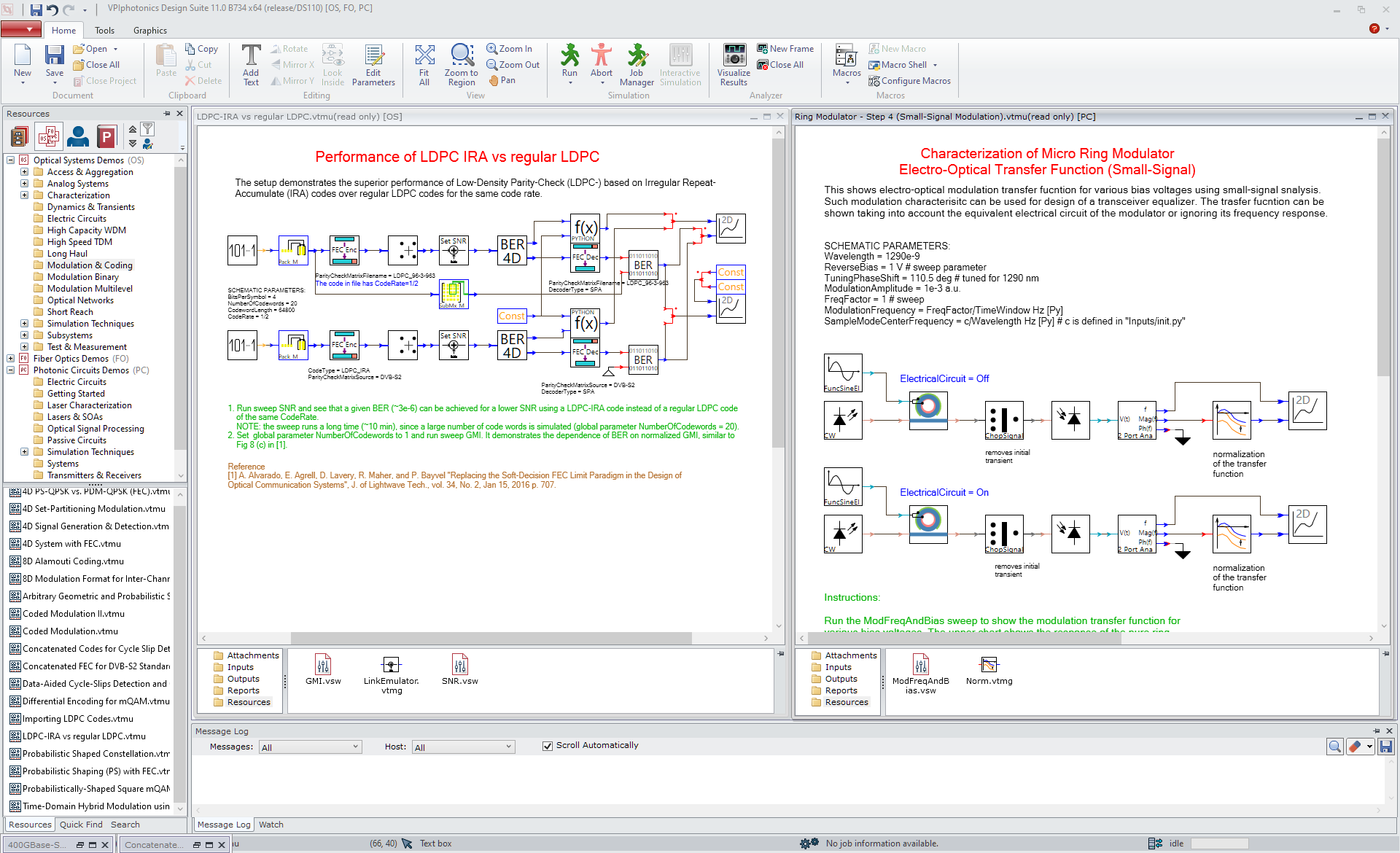VPIphotonics Design Suite Version 11.0 provides access to professional application-specific simulation tools and several pluggable toolkit extensions with common usability, design process and data analysis capabilities.
Version 11.0 offers advances in simulation and design capabilities for applications using
Forward Error Correction (FEC), Digital Signal Processing (DSP), multimode VCSELs and fibers,
integrated optical modulators, nonlinear waveguides, and more.
VPIphotonics' software solutions have proven to be beneficial in winning and successfully
performing many research and design projects – for commercial companies as well as for
educational institutions. With the improved capabilities provided in Version 11.0, our
modeling suite is set to deliver the same outstanding results in the future.

Photonic Design Environment (PDE) of Version 11.0
BCH and concatenated FEC – The FECencoder module supports now Bose-Chaudhuri-Hocquenghem (BCH) FEC codes; an illustration is added on how to perform concatenated FEC encoding (inner code: BCH, outer code: LDPC-IRA) and appropriate FEC decoding via parity check matrix and decoding algorithm; a new macro calculates the message length for the specified code length and error correction capability.
IQ imbalance correction – The DSP_Lib module provides a new algorithm for compensating the phase and amplitude imbalance between I and Q branches of a 90-degree optical hybrid.
Overlap-save for aperiodic simulations – The FiberNLS and BC_Converter modules can work in overlap-save operation now to better support multi-run aperiodic simulations with time-domain DSP algorithms.
PAM Jitter – The jitter algorithm in the Tx_El_PAM_M transmitter has been improved to speed-up simulations with long symbol sequences.
SWDM optical interconnects – New illustration and updated macro for generating doping- and refractive index profiles for wideband multimode fibers to support shortwave wavelength division multiplexing (SWDM) optical interconnect solutions; updated testbeds for measuring wavelength-dependent EMBc and OMB characteristics; new illustration of dual-wavelength PAM4 transmission link with multimode VCSELs and a wideband fiber based on the 400GBASE-SR4.2 specification.
User Projects – It is now possible to organize all user resources including libraries, demonstrations, macros, documentation in a single place to easily exchange them.
Order of module execution – The execution order of modules can be controlled manually if their connectivity does not determine the execution order unambiguously.
Exclusion of schematic parts – You can now simply exclude parts of the schematic parts from simulation, for instance, to save simulation time when debugging a complex schematic.
Searching the message log – A new panel in the Message Log allows you to search through all messages.
Multimode VCSEL – Updated model to support 5th order Runge-Kutta method for higher accuracy; new model parameters to shorten simulation time of initial transients and their removal at the module output; new testbeds for measuring light-current curve, modulation transfer function, and relative intensity noise.
Silicon Photonics Microring Modulator – New demo module for circuit-level modeling of silicon microring modulators (MRM) with a carrier-depletion type phase shifter, including behavioral and physical junction models and accounts for parasitics of the device itself and connecting wires; several new testbeds for static and dynamic MRM characterizations.
Nonlinear dispersive waveguide – New module that provides a time-domain sample mode model for simulations of bidirectional nonlinear dispersive optical waveguides; new illustrations addressing frequency combs in nonlinear ring resonators, soliton formation and supercontinuum generation in nonlinear waveguides.
Measured passive components – New macro that simplifies creation of passive photonic components for SMATRIX simulations, based on measured or pre-calculated device scattering matrices.
Display of photon flux units – OSA and Scope can now display optical signals in photon flux units, especially useful for QKD applications.
Display of signal power / energy – Placing two vertical markers on SignalAnalyzer traces allows access to signal power or energy information via the integrated area between them.
Statistical measures in analyzers – Mean, variance, and standard deviation of the input data can be calculated now using unbiased or maximum likelihood estimation.
Copying signals – Optical and electrical signals can be copied preserving all signal data to apply advanced signal analysis and signal processing.
Insert graphics in charts – Graphics can now be inserted into analyzer charts from files for better annotation of the simulation results.
Python Support – Python 3.7 is now the default Python version (while Python 2 is still fully supported).
Many new demo examples have been added and existing ones modified to illustrate the functionality and applications of the new features and modules. Version 11.0 provides access to over 870 ready-to-run demo setups now.